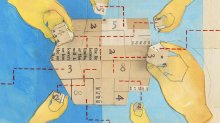How to Deepen Math Learning With Word Sorts
Students can use an old ELA tactic—word sorts—to understand how different math concepts are related, allowing them to decode increasingly complex problems.
Your content has been saved!
Go to My Saved Content.At Concourse Village Elementary School in the Bronx, solving math problems doesn’t always start with diving into the numbers. Here, students focus on the words first, reading the problem out loud with the teacher, identifying common words and phrases, and discussing the broader narrative hidden within the problem.
When facing a complex math task, discussing strategies with peers and posing questions before attempting to solve it allows students to verbalize their thinking and test out theories—and develops the content-specific vocabulary to do so. “As students move through the grades, vocabulary knowledge plays an increasingly important role in the learning experience,” write educators Miranda L. Sigmon, Kavin Ming, and Daniel Herring, in Mathematics Teacher: Learning and Teaching PK-12, a journal by the National Council of Teachers of Mathematics.
But vocabulary instruction isn’t always a priority in the math classroom, because “literacy and mathematics are often seen as unrelated subjects, which makes mathematics teachers less likely to consider the many ways in which literacy is interwoven throughout mathematics content,” the authors write. That’s where a “simple yet powerful strategy” like word sorts—a common practice in the ELA classroom where students identify shared features of words’ meanings and place them into groups based on spelling, linguistic features, or meanings—can help.
Math learners across grade levels can use word sorts to gain a deeper understanding of how different math concepts connect, allowing them to decode increasingly complex problems, and building critical disciplinary literacy. Here are three ways to use word sorts in the math classroom.
Differentiate Between Open and Closed Sorts
With closed sorts, the teacher defines the categories beforehand and students do the sorting. For open sorts, students come up with their own classifications—and construct a justification for which terms belong to which group. Closed sorts allow for greater teacher scaffolding, while open sorts encourage students to grapple independently with the content.
For example, a lesson on increments of measurement might involve a list of keywords such as: Kilometer, Meter, Centimeter, Hour, Second, Minute, Kilogram, Gram, Ounce, and Pound. For a closed sort, consider providing ready-made categories like Distances, Intervals of Time, Liquid Volumes, Masses of Objects, and Not Sure.
For an open sort, you wouldn’t provide prompts and students would work at figuring out categories and word placements by themselves. With both types of sorts, carve out time for a group discussion so students can explain their groupings and practice verbal reasoning skills.
Make Sorting Visual
Certain math concepts fit neatly into categories—like measurements or types of functions. But many other math terms “follow more of a hierarchical structure,” making it tougher to facilitate as a categorical word sort. Using a simple chart or a graphic organizer to visualize hierarchical terms can help clarify where they stand within a complex structure.
At the elementary level, when students are learning about a rhombus, for example, “they must know that the qualities of the shape make it fall into multiple categories, including parallelogram, quadrilateral, and two-dimensional,” write the authors. Since a rhombus could belong to multiple categories, it would be more accurate to put the rhombus as a subset within a parallelogram, which is then a subset of a quadrilateral, they explain. By creating a visual mapping of shapes that belong to multiple categories, students can see a clear relationship between adjacent concepts while being able to make connections across a broad category—in this case, a two-dimensional shape—and its corresponding examples.
But a graphic organizer isn’t just useful in illustrating geometric concepts, it can be used to help middle school students solidify a foundation of algebra, too. “Because of these connections across functions, this content would work well for an association sort,” the authors write. “For example, Equation and Expression share several common words that include Terms, Coefficients, Variables, and Constants.”
The authors also suggest giving students a list of terms as a reference, or creating a word wall in the classroom so that students have a handy guide while they solve problems.
Talk It Out
Working on word sorts as partners or in small groups can motivate students to “have discipline-focused conversations about vocabulary terms,” which helps solidify math proficiency, write Sigmon, Ming, and Herring. Consider providing sentence starters to ease the pressure students may feel about having to explain or discuss a complicated theory or concept.
For categorical sorts, the authors suggest sentence stems such as: “I think (insert term) goes under the (category name) category because . . .” or “(insert term) means (insert definition), so it most likely belongs in the (category name) category.” To make sure sentence stems kickstart a real dialogue, introduce them before students split into groups or pairs, and consider quickly modeling the practice yourself. For a word sort about rational vs. irrational numbers, for instance, you could say: “I think the square root of 2 goes under the irrational numbers category because the answer cannot be written in decimal form because it is non repeating.”
Math vocabulary can be “dense, technical, and symbolic in nature,” the authors conclude. Mastering mathematical concepts requires that students learn “to think about both the unique characteristics and structural elements of—as well as the common features across—words.” Exercises like math word sorts, with explicit modeling from teachers, help students learn to “think, speak, read, and write like mathematicians.”
